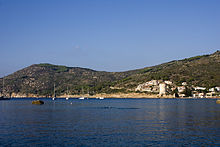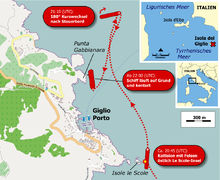Giglio (island)
| Giglio | ||
|---|---|---|
| Giglio seen from Monte Argentario | ||
| Waters | Tyrrhenian Sea | |
| Archipelago | Tuscan Archipelago | |
| Geographical location | 42 ° 21 '57 " N , 10 ° 54' 7" E | |
|
|
||
| length | 9 km | |
| width | 4.5 km | |
| surface | 21.21 km² | |
| Highest elevation | Poggio della Pagana 496 m slm |
|
| Residents | 1420 (2017) 67 inhabitants / km² |
|
| main place | Giglio Castello | |
| Map of the Tuscan Archipelago | ||
Giglio is an island in the Mediterranean Sea that, together with the neighboring island of Giannutri, forms the municipality of Isola del Giglio in the Grosseto province of Tuscany in Italy . The name Giglio goes back to the Latinization Aegilium , derived from the Greek word aix, aigos (goat): island of goats .
geography
The island is located about 50 kilometers southeast of Elba and about 18 kilometers west of the Monte Argentario peninsula . The neighboring islands are Elba, Pianosa , Giannutri , which belongs to the municipality of Giglios, and the uninhabited island of Montecristo .
The coast has a length of 28 kilometers, the highest point of the island is the Poggio della Pagana with a height of 496 m slm .
There are three larger towns on the island of Giglio: Giglio Porto, on the east side of the island facing the mainland, is the only seaport of Giglio. With 607 inhabitants, Porto is the largest place on Giglio - according to the results of a 2011 census.
Giglio Castello , the capital of the island, 405 meters above sea level, is enclosed by a medieval wall and crowned by a fortress of the Aldobrandeschi . The place belongs to I borghi più belli d'Italia (the most beautiful places in Italy) . At the 2011 census, Castello had 554 inhabitants.
In the west of the island, in a bay and on the only larger sandy beach on the island, Giglio Campese is located , whose landmark is the old Medici defense tower by the sea. Campese had a total of 187 inhabitants at the 2011 census.
Other small settlements are Arenella with fourteen and Villaggio Grotte with three inhabitants. 26 residents reside in scattered residential buildings that are not assigned to any settlement.
For the first time in the Mediterranean area , so-called plastic crusts were detected on Giglio in 2019, which are caused by plastic waste in the seas .
economy
Campese is now a tourist place. In front of Campese there are some reefs that can already be seen from the road and extend to over 50 meters deep.
In the past, granite , iron ore and pyrite were mined on the island . The pyrite mine was closed in 1962 and since then tourism and, on a small scale, agriculture have been the island's main industries. There are many diving areas around the island .
history
Early history
The island in its current form was probably formed 5 to 4.5 million years ago. The island has been inhabited since the Iron Age and the Etruscans used it as a military base. Also in the Roman Empire it was an important base in the Tyrrhenian Sea as insula aegilium or insula igillia , Caesar briefly mentioned the island in his de bello civili . On the edge of Giglio Porto, just below sea level, lie the remains of a large Roman villa belonging to the Domizi Enobarbi family. These are the walls of a fish farm, as well as the structures along the bay with a series of arches and a terrace.
Middle Ages and Modern Times
In 805 Charlemagne donated the island to the Tre Fontane monastery in Rome . Later it was owned by various Tuscan families (especially the Aldobrandeschi ) and the city of Perugia . In 1241 the Sicilian fleet of Frederick II destroyed a Genoese fleet here during the sea battle of Giglio . From 1264 to 1406 Giglio was owned by the Pisans , then it went to the Medici . Until 1799 the island was attacked several times by the Saracens , for example by the pirate Khair ad-Din Barbarossa in 1544 , with more than 700 inhabitants being killed or deported as slaves. The Medici family then settled people from the Siena region on the island, had coastal towers built and the city walls of the town of Castello reinforced. The pirate attacks in Tuscan waters continued until 1799.
On June 14, 1646, in the nearby battle of Orbetello, Grand Admiral Jean Armand de Maillé was killed on his flagship, the Grand Saint Louis .
At the beginning of the 20th century, pyrite was extracted in the mines near Campese . Tourism began in the 1960s and is now the island's main source of income.
Average of the Costa Concordia
On January 13, 2012, the cruise ship Costa Concordia ran aground off the island of Giglio , had a leak and drifted directly in front of the port of Porto, where it capsized, partially sank and remained lying at about 65 degrees. 32 people died. The salvage work lasted more than two years. On September 16, 2013, after extensive preparations, the wreck was brought into an upright position. It was then made buoyant and towed to Genoa on July 23, 2014 .
Facilities
There is also a marine biology institute on the island for research into marine flora and fauna.
traffic
The Toremar and Maregiglio ferry lines connect the island with the mainland in Porto Santo Stefano six times a day and also transport vehicles. The neighboring island of Giannutri can also be reached with Maregiglio, there is also a connection between the two islands.
There is a bus line on the island that runs between Giglio Porto and Giglio Campese; Giglio Castello is always approached. The travel times between Porto and Castello and Castello and Campese are each 15 minutes. The bus timetable is based on the arrival and departure times of the ferries.
Web links
- Isola del Giglio municipality
- Associazione Pro Loco Isola del Giglio e Giannutri
- Giglioinfo.it
- Chart of the Giglio area
Individual evidence
- ↑ The meaning of the Italian word giglio = lily was not decisive: http://www.isoladelgiglio.net/storia.php Informazioni storiche dell'isola (information on the history of the island), accessed on July 30, 2009
- ↑ Nautical map on mytopo.com. Retrieved January 18, 2012 .
- ↑ Daniel Lingenhöhl: Environmental pollution: plastic rust is spreading. In: Spektrum.de . November 15, 2019, accessed November 18, 2019 .
- ↑ Giusto Monaco: Aegilium Insula (Giglio) Etruria, Italy . In: Richard Stillwell et al. a. (Ed.): The Princeton Encyclopedia of Classical Sites. Princeton University Press, Princeton NJ 1976, ISBN 0-691-03542-3 .
- ^ Homepage of Toremar
- ^ Homepage of Maregiglio







